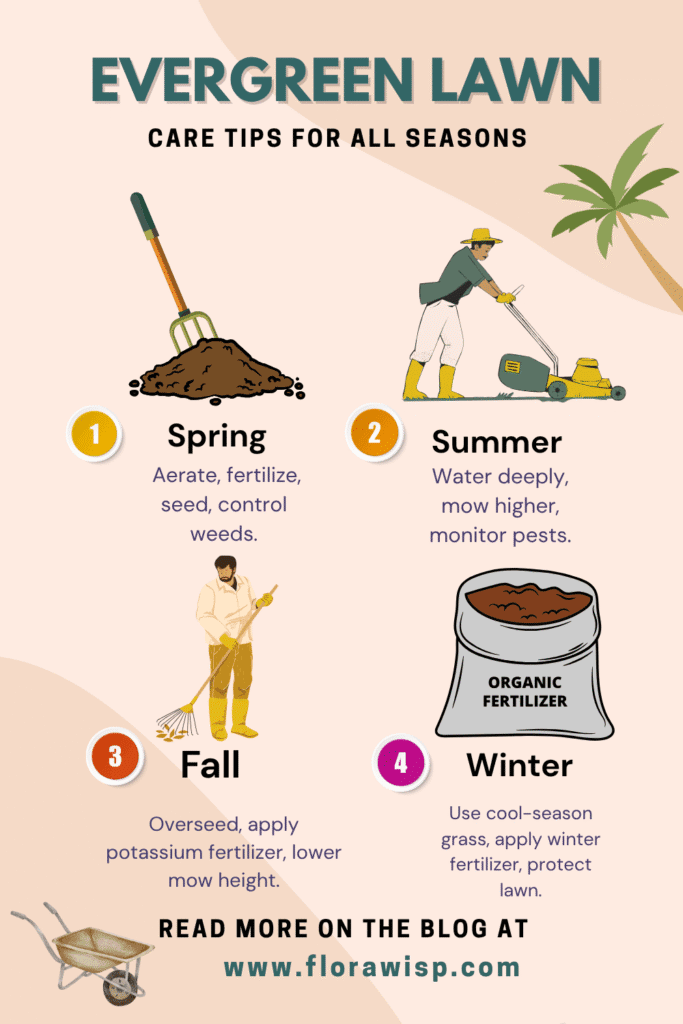Evergreen grass care starts with choosing the right grass variety and adjusting your lawn practices to match your climate. For warm regions like the southern U.S., grasses like Bermuda, Zoysia, or TifBlair Centipede can stay green longer with proper mowing, watering, and soil care. In cooler areas, tall fescue or perennial ryegrass offer year-round color when overseeded correctly. The key is to support consistent root health through deep, infrequent watering, seasonal aeration, and using nitrogen-rich fertilizer in early spring and fall.
Mow high during hot months to reduce stress and retain moisture, and always sharpen mower blades to prevent turf damage. Winter browning can be minimized by reducing foot traffic, avoiding overwatering, and overseeding with cool-season grasses where needed. Whether you’re in Zone 7 or 9, the foundation of all-year green grass is soil health, the right seed, and season-specific care. A thoughtful evergreen lawn plan doesn’t just boost color it protects your turf from pests, drought, and temperature swings while keeping your yard beautiful in every season.
In This Article
Preparing the Lawn
Before diving into daily and seasonal care, preparing your lawn sets the foundation for strong, healthy growth. Planting grass seeds requires attention to soil condition, seed type, and proper timing. In early spring grass care, the focus is on clearing debris, loosening the soil, and selecting the right seed variety for your region, ensuring a strong foundation for healthy grass growth.
For those in warmer climates such as Florida, paying extra attention to choosing warm-season grass varieties is essential. This helps ensure your lawn thrives in the local conditions, while also setting you up for easier care throughout the year.
For best results, plan your spring grass care by focusing on practices like aerating the soil, applying starter fertilizer, and monitoring moisture levels. These steps not only prepare your lawn for healthy growth but also help new grass seeds establish strong roots before the heat of summer.
Watering New Grass Seeds
Watering is a crucial part of evergreen grass care, especially when nurturing new grass seed. From my gardening experience, proper moisture management ensures healthy seed germination and strong root development without risking common problems.
- How long does it take to water the new grass seed?
Water new grass seed for about 5 to 10 minutes each session. This duration moistens the soil to a depth of 1 to 2 inches, encouraging roots to grow deep and develop strong base. - How often do I water new grass seeds?
During the first two weeks after planting, water 2 to 3 times daily to keep the soil consistently moist. Once seedlings start growing, reduce watering to once a day to help roots strengthen and adjust to natural conditions. - How much to water new grass seed?
Aim to provide around 1 to 1.5 inches of water per week, divided into several watering sessions. This approach prevents water runoff and allows the soil to absorb moisture evenly, promoting healthy, uniform growth.
Can you overwater grass seed? Yes, but overwatering can harm your lawn. Excess water leads to soggy soil, which deprives seeds of oxygen, causing root rot, fungal growth, and mold. To avoid this, water deeply but allow the top inch of soil to dry slightly between sessions. Adjust your watering based on soil type and weather conditions, monitoring moisture regularly.
By following these watering guidelines, your lawn will thrive through effective spring grass care, establishing a lush and resilient evergreen landscape that lasts all year.
Seasonal Lawn Care: Keeping Your Grass Healthy Year-Round

Maintaining a healthy lawn year-round requires adapting your care routine to the seasons. Tailoring your efforts for each period of spring, summer, fall, and winter ensures your grass stays resilient against weather stress, pests, and diseases.
Spring Grass Care
Spring is the ideal time to revitalize your lawn. Start by raking and removing debris to allow air and sunlight to reach the soil. For thin or bare patches, it’s smart to Plant Grass Seed in Spring so new growth blends seamlessly with your existing turf. Apply balanced fertilizer to promote strong shoots and deep roots. Weed control is essential during this season, either with targeted herbicides or by hand. Regular watering adjusted for local weather keeps moisture levels optimal.
Early Spring & Florida Lawn Care
In warmer climates like Florida, early spring lawn care focuses on warm-season grasses such as Bermuda and St. Augustine. Begin fertilization as temperatures rise, but avoid overfeeding. Watch for local pests and diseases and manage them promptly. Aerating the soil and selecting the right grass variety for your region helps establish a strong foundation for the hot months.
Summer Lawn Care
Summer care focuses on keeping your grass healthy through heat and drought stress. Water deeply but less frequently preferably early in the morning to encourage deep root growth and reduce evaporation. Mow at a slightly higher height to shade the soil and protect against heat. Avoid fertilizing during the peak heat to prevent burning the grass. Consistent monitoring for pests and diseases, especially in humid areas, is crucial during this season.
Fall Lawn Care for Bermuda Grass
As Bermuda grass transitions into dormancy, lower your mowing height to prevent matting. Apply a fall fertilizer rich in potassium to strengthen roots and improve cold tolerance. Overseeding thin spots helps prepare for a vibrant spring comeback. For homeowners considering planting grass seed in fall, this is the ideal time to establish new growth before winter sets in. This preparation supports a healthy, green lawn next season.
How to Keep Grass Green in Winter
Keeping your lawn evergreen through the colder months can feel challenging, but with the right evergreen grass care approach, it’s possible to maintain a lush, year-round look.
Choose the Right Grass Type
Start by selecting cool-season grasses like fescue or ryegrass, which stay green even in winter. If your lawn features warm-season varieties like Bermuda grass, consider overseeding them with cool-season options for added coverage and color during dormancy. To learn more about overseeding Bermuda grass effectively, check out our detailed guide on Bermuda grass.
Apply Winter Fertilizer
Use a balanced fertilizer that’s rich in potassium and low in nitrogen. Potassium strengthens the grass’s resilience against cold temperatures and promotes deeper root growth, which supports winter greenness.
Adjust Mowing and Watering
Keep your grass slightly taller than usual during winter, as longer blades protect roots and conserve moisture. Reduce mowing frequency and only water during dry, unfrozen periods to prevent dehydration.
Protect Your Lawn
In areas prone to frost or ice, consider using breathable covers or frost cloths to shield your grass from extreme conditions. Minimize foot traffic to prevent compaction and damage when the grass is more fragile.
Monitor for Pests and Disease
Winter stress can make grass susceptible to fungal issues like snow mold. As part of effective evergreen grass care, keep the lawn free of debris, watch for signs of trouble, and address issues promptly to maintain its health.
A well-maintained lawn isn’t just about summer beauty, it’s about year-round resilience. With these strategies, you can enjoy a green, healthy lawn that stands strong even through winter’s chill.
FAQs
Q. Can grass seed go bad?
Yes, grass seed can lose its germination ability over time, especially if exposed to moisture or heat. Proper storage in a cool, dry place helps maintain viability.
Q. How to keep birds from eating grass seed?
Cover the seeded area with straw or netting immediately after planting. Scare tactics like reflective tape or decoy predators can also help.
Q. Do birds eat grass seed?
Absolutely. Birds find grass seed appealing. Without protective measures, they can significantly reduce seed establishment rates.
Q. Does frost kill grass seed?
Frost can delay germination but doesn’t typically kill dormant seeds. However, frost damage is possible if seeds sprout prematurely.
Q. How to keep grass green in winter?
Evergreen grass care in winters involves using winter fertilizers, overseeding with cool-season grasses, and adjusting your routine to support color retention during colder months. Protective measures against frost and reduced mowing also play a key role.
Conclusion
By mastering evergreen grass care, you’ll ensure your lawn stays lush, healthy, and vibrant no matter the season. Whether you’re starting with planting grass seeds, applying essential spring grass care tips, or preparing for the challenges of different seasons, this guide offers the knowledge and strategies you need to keep your lawn thriving. A healthy lawn is a journey, not just a destination and now you’re equipped to nurture it year-round.
Sources:
The Spruce – Lawn Care Advice and Tips
Scotts – Guide to Lawn Watering Systems and Methods
Gardener, M.Sc. Horticulture
Elara Bennet is a gardening writer from Austin, TX, passionate about sustainable lawns and blooms. Read full bio →








